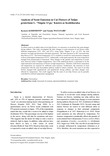Analysis of Scent Emission in Cut Flowers of Tulipa gesneriana L. ‘Niigata 13 go,’ Known as Koshiharuka
JARQ : Japan Agricultural Research Quarterly
| ISSN | 00213551 |
|---|---|
| 書誌レコードID(総合目録DB) | AA0068709X |

本文フルテキスト
jarq57-3_217-224.pdf6.45 MB
To utilize scent as an added value of cut tulip flowers, it is necessary to reveal how the scent changes during anthesis. This study investigated the daily changes in scent emission of cut flowers under different temperatures (13℃, 18℃, and 23℃), using Tulipa ‘Niigata 13 go.’ At 23℃, the total emission was high and decreased with tepal senescence. The total emissions at 18℃ increased later than those at 23℃. The lowest temperature (13℃) resulted in overall low scent emissions compared to those at the highest temperature of 23℃. Additionally, as the tepals matured, the scent composition changed from monoterpene to benzenoid. These changes in the quantity and composition of scents were observed earlier at higher temperatures. One of the underlying factors is presumed to be the rapid maturation and senescence of flowers at high temperatures. Therefore, both flower maturation and temperature are required for sufficient scent emission. Furthermore, the emissions of scent components with the same biosynthetic pathway tended to behave similarly. The scent of cut tulip flowers changed both quantitatively and qualitatively during anthesis, and these changes were affected by temperature. This result suggests that the scent of cut tulip flowers can be partially controlled by artificial temperature management.
| 刊行年月日 | |
|---|---|
| 作成者 | Kyutaro KISHIMOTO Yusuke WATANABE |
| 著者キーワード | benzenoid β-ocimene phenylacetaldehyde terpenoid tulip |
| 公開者 | Japan International Research Center for Agricultural Sciences |
| 受付日 | 2022-08-30 |
| 受理日 | 2022-11-14 |
| オンライン掲載日 | |
| 巻 | 57 |
| 号 | 3 |
| 開始ページ | 217 |
| 終了ページ | 224 |
| DOI | 10.6090/jarq.57.217 |
| 言語 | eng |
